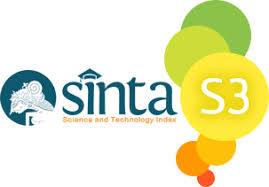Preferensi Mahasiswa Terhadap Marketing Communication Mix
 Abstract views: 713
,
Abstract views: 713
,
 PDF downloads: 759
PDF downloads: 759
Abstract
By using multiple marketing communication mix tools for private college probably spent expenses. The results of preference from students who have received various promotions and finally chose a X private college in Surabaya with the highest value of 9.05 is the existence of an expo or education exhibition since they at junior high school. Actively presentation about the benefits of an institution directly to the target market is the main preference of eleven (11) other marketing communication mix tools. Hopefully this research can be a reference for future promotion planning so much more effective in choosing a marketing communication mix tools that will use by X private college.
Â
Keywords: Preference, marketing communication mix, private college
References
Alma, Buchari. 2009. Manajemen Pemasaran dan Pemasaran Jasa. Bandung: Alfabeta.
Ary, M. 2016. “Menentukan Prioritas Pilihan Mahasiswa Dalam Memilih Kampus Menggunakan Analisis Conjoitâ€. Jurnal Paradigma (13).
Brown, Varley, dan Pal. 2008. University course selection and services marketing. Marketing Intelligent & Planning, 27 (3): 310-325.
Flavian, C., Guinaliu, M. & Torres, E. 2005. “The influence of corporate image oh consumer trust: a comparative analysis in traditional versus internet bankingâ€. Internet Research, 15 (4): 447-71.
Harjana. Andre A. 2007. Audit Komunikasi, Teori dan Praktek. Grasindo: Jakarta.
J. Supranto, M. 2000. Statistik: Teori dan Aplikasi Edisi Keenam. Jakarta: Erlangga.
Kotler, Philip dan Gary Armstrong. 2006. Principles of Marketing. US: Pearson Prentice-Hall, Inc.
Kotler, Philip dan Gary Armstrong. 2012. Prinsip-prinsip Pemasaran Edisi 13 Jilid 1. Jakarta : Erlangga.
Kotler, Philip dan Karen F.A. Fox. 1995. Strategic Marketing for Educational Institutions 2nd Editions. New Jersey: Prentice-Hall, Inc.
Krejcie, Robert V. dan Daryle W. Morgan. 1970. Ditermining Sample Size for Research Activities. Educational and Psychological Measurment (30): 607-610.
Monika Teguh, H. Y. 2017. Strategi Promotional Mix Pada Perguruan Tinggi X Di Surabaya. Prosiding Asian Games 2018 Wahana Pariwisata Dan Komunikasi Antar Bangsa. PPP-UBD Press: 253-261.
Muhammad, Arni.2007. Komunikasi Organisasi. Bumi Aksara.
Munandar, J. M. Udin, F., Amelia, M. 2012. Analisis Faktor Yang Mempengaruhi Preferensi Konsumen Produk Air Minum Dalam Kemasan di Bogor. Jurnal Teknologi Industri Pertanian IPB (13).
Nicholson, Walter. 1989. Microeconomics Theory: Basic Principles and Extensions (Teori Ekonomi Mikro I, alih bahasa: Deliarnov). Jakarta: CV Rajawali.
Reina. 2012. Faktor-faktor yang Mempengaruhi Kepuasan Mahasiswa pada Universitas Bina Nusantara. Binus Business Review 3(1): 563-572.
Setiyawan. 2016. Membangun Citra Kampus Melalui Kepuasan Mahasiswa Berdasarkan Kualitas Layanan. STIE Malang Kucecwara Malang (2): 21-46.
Soutar, G.N. dan Turner, J.P. 2002. Students’ preferences for unversity: A conjoint analysisâ€, The International Journal of Educational Management (16): 40-5.
Tjiptono, Fandy. 2011. Seri Manajemen Merek 01: Manajemen & Strategi Merek. Yogyakarta: ANDI
Todorova, G. (2015). Marketing Communication Mix. Trakia Journal of Sciences, 368-374.
Wiryanto. (2008). Pengantar ilmu komunikasi. Jakarta: Gramedia Widiasarana Indonesia.
Copyright (c) 2018 Jurnal Komunikasi Profesional

This work is licensed under a Creative Commons Attribution-ShareAlike 4.0 International License.

Jurnal Komunikasi Profesional is licensed under a Creative Commons Attribution-ShareAlike 4.0 International License.
1. Proposed Policy for Journals That Offer Open Access
Authors who publish with this journal agree to the following terms:
- Authors retain copyright and grant the journal right of first publication with the work simultaneously licensed under a Creative Commons Attribution License that allows others to share the work with an acknowledgment of the work's authorship and initial publication in this journal.
- Authors are able to enter into separate, additional contractual arrangements for the non-exclusive distribution of the journal's published version of the work (e.g., post it to an institutional repository or publish it in a book), with an acknowledgement of its initial publication in this journal.
- Authors are permitted and encouraged to post their work online (e.g., in institutional repositories or on their website) prior to and during the submission process, as it can lead to productive exchanges, as well as earlier and greater citation of published work (See The Effect of Open Access).
2. Proposed Policy for Journals That Offer Delayed Open Access
Authors who publish with this journal agree to the following terms:
- Authors retain copyright and grant the journal right of first publication, with the work [SPECIFY PERIOD OF TIME] after publication simultaneously licensed under a Creative Commons Attribution License that allows others to share the work with an acknowledgement of the work's authorship and initial publication in this journal.
- Authors are able to enter into separate, additional contractual arrangements for the non-exclusive distribution of the journal's published version of the work (e.g., post it to an institutional repository or publish it in a book), with an acknowledgement of its initial publication in this journal.
- Authors are permitted and encouraged to post their work online (e.g., in institutional repositories or on their website) prior to and during the submission process, as it can lead to productive exchanges, as well as earlier and greater citation of published work (See The Effect of Open Access).



